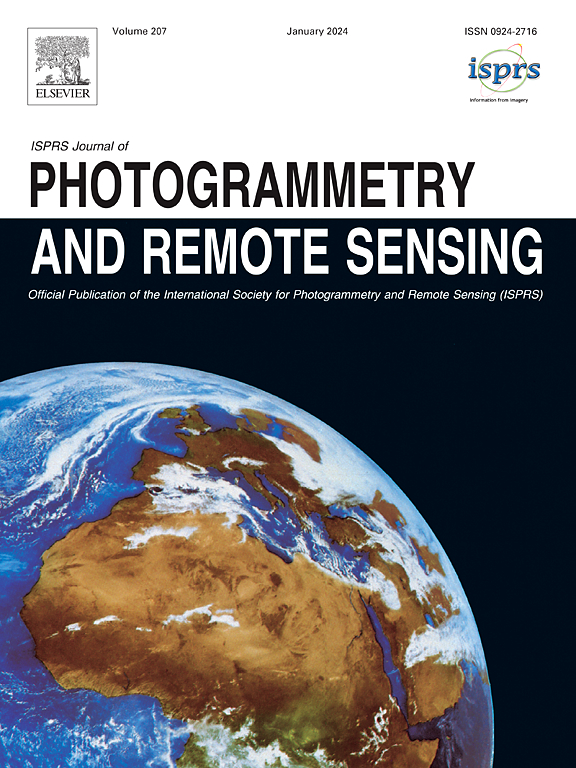基于混合智能的非授权农田挖掘场景认知
IF 10.6
1区 地球科学
Q1 GEOGRAPHY, PHYSICAL
ISPRS Journal of Photogrammetry and Remote Sensing
Pub Date : 2025-06-21
DOI:10.1016/j.isprsjprs.2025.06.016
引用次数: 0
摘要
擅自挖掘农田,是指未经合法授权或者违反有关规定,在农田边界内进行挖掘、开采及相关资源开发等活动。这些活动直接造成农田的破坏和功能退化,对国家粮食安全和社会稳定构成重大威胁。利用视频识别的现有农田监测方法存在局限性,包括高误报率和低自动化水平。为了解决这些问题,本文提出了一种基于混合智能的认知方法来分析未经授权的农田挖掘活动的视频场景。在数据层面,构建了工程机械在非授权农田开挖场景中行为交互的视频数据集,结合时空维度,全面刻画了机械之间的交互特征。在算法层面,考虑到视频场景中物体运动频繁、时效性要求高的特点,整合专家知识对YOLOv8进行增强,具体提出了一种基于混合智能的物体行为识别模型,能够准确捕捉同一物体在不同行为下的细微特征差异。在推理阶段,构建了知识图谱和推理机制,将动态视频信息与领域知识深度融合,克服了对象交互识别不完全的难题,实现了对非法耕地挖掘活动的精准识别。对比实验充分验证了该模型在识别细微特征差异方面的优越性。与最新的单阶段目标检测模型YOLO11相比,本文提出的目标行为识别模型F1分数提高了3.26%(从85.17%提高到88.43%)。烧蚀实验进一步证实了专家知识的有效性。例如,CSPELAN模块通过多尺度特征知识增强,F1分数提高了3.75%(从84.29%提高到88.04%)。研究成果不仅为农田保护提供了高效可靠的技术支撑,也为地理空间情报分析领域的理论创新和技术发展提供了宝贵的实践经验和方法参考。本文章由计算机程序翻译,如有差异,请以英文原文为准。
HIUFE: Hybrid intelligence-based unauthorized farmland excavation scene cognition
Unauthorized farmland excavation refers to activities such as digging, mining, and related resource development within farmland boundaries, conducted without legal authorization or in violation of relevant regulations. These activities directly contribute to the destruction and functional degradation of farmland, posing significant threats to national food security and social stability. Existing farmland monitoring methods utilizing video recognition exhibit limitations, including high false positive rates, and low levels of automation. To address these challenges, this paper proposes a hybrid intelligence-based cognitive approach to video scene analysis for unauthorized farmland excavation activities. At the data level, a video dataset capturing the behavioral interactions of construction machinery in unauthorized farmland excavation scenes is constructed, incorporating temporal and spatial dimensions to comprehensively depict interaction features among the machinery. At the algorithmic level, considering the frequent motion of objects and the high timeliness requirements in video scenes, expert knowledge is integrated to enhance YOLOv8, specifically proposing a hybrid intelligence-based object behavior recognition model that accurately captures subtle feature differences in the same object under different behaviors. During the inference phase, a knowledge graph and reasoning mechanism are constructed to deeply integrate dynamic video information with domain knowledge, overcoming the challenge of incomplete recognition of object interaction and achieving precise identification of unauthorized farmland excavation activities. Comparative experiments thoroughly validate the model’s superiority in identifying subtle feature differences. Compared to the latest single-stage object detection model, YOLO11, the proposed object behavior recognition model improves the F1 score by 3.26% (from 85.17% to 88.43%). Ablation experiments further confirm the effectiveness of incorporating expert knowledge. For example, the CSPELAN module, enhanced with multi-scale feature knowledge, increases the F1 score by 3.75% (from 84.29% to 88.04%). The research outcomes not only provide efficient and reliable technical support for farmland protection, but also contribute valuable practical experience and methodological references to theoretical innovation and technological development in the field of geospatial intelligence analysis.
求助全文
通过发布文献求助,成功后即可免费获取论文全文。
去求助
来源期刊

ISPRS Journal of Photogrammetry and Remote Sensing
工程技术-成像科学与照相技术
CiteScore
21.00
自引率
6.30%
发文量
273
审稿时长
40 days
期刊介绍:
The ISPRS Journal of Photogrammetry and Remote Sensing (P&RS) serves as the official journal of the International Society for Photogrammetry and Remote Sensing (ISPRS). It acts as a platform for scientists and professionals worldwide who are involved in various disciplines that utilize photogrammetry, remote sensing, spatial information systems, computer vision, and related fields. The journal aims to facilitate communication and dissemination of advancements in these disciplines, while also acting as a comprehensive source of reference and archive.
P&RS endeavors to publish high-quality, peer-reviewed research papers that are preferably original and have not been published before. These papers can cover scientific/research, technological development, or application/practical aspects. Additionally, the journal welcomes papers that are based on presentations from ISPRS meetings, as long as they are considered significant contributions to the aforementioned fields.
In particular, P&RS encourages the submission of papers that are of broad scientific interest, showcase innovative applications (especially in emerging fields), have an interdisciplinary focus, discuss topics that have received limited attention in P&RS or related journals, or explore new directions in scientific or professional realms. It is preferred that theoretical papers include practical applications, while papers focusing on systems and applications should include a theoretical background.
 求助内容:
求助内容: 应助结果提醒方式:
应助结果提醒方式:


